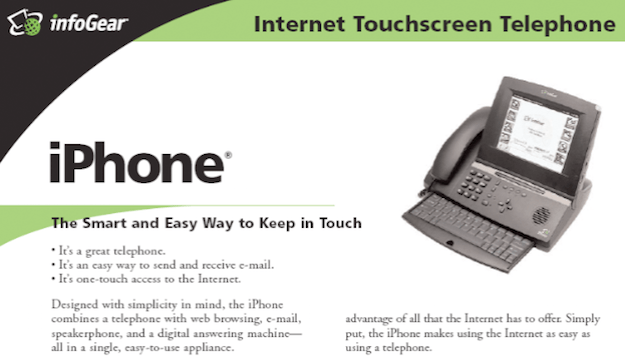 December 18, 2006: Apple fans mourn the death of the iPhone before it even launches.
December 18, 2006: Apple fans mourn the death of the iPhone before it even launches.
After Linksys begins selling new handsets, Cupertino watchers must come to grips with the fact that Apple’s rumored smartphone probably won’t be called the iPhone after all. Why? Because Linksys’ parent company, Cisco Systems, owns the iPhone trademark, despite Apple previously having made the iMac, iBook, iPod and iTunes.
This post contains affiliate links. Cult of Mac may earn a commission when you use our links to buy items.
The new iPhone … from Cisco?
Rumors of the other iPhone’s release took the internet by surprise. Before word spread that this was a Cisco device, many people speculated that Apple was debuting its smartphone out of nowhere. A few days before Cisco’s announcement, Gizmodo writer Brian Lam wrote that the iPhone would be announced on this day in 2006.
“I guarantee it,” the cryptic article read. “It isn’t what I expected at all. And I’ve already said too much.”
Although fans expected an iPhone from Apple, most people figured that would land in early 2007. (That’s exactly when Steve Jobs showed off the company’s now-famous device for the first time.)
Confusingly, Cisco’s new Voice over Internet Protocol, or VoIP, handsets were part of a family of devices branded as iPhones, although they were actually called the CIT400 and WIP320. The $179.99 CIT400 was a cordless phone with a base station that attached directly via Ethernet to a network. The $199.99 WIP320, meanwhile, was compatible with Wi-Fi. Both came preloaded with Skype.
A story dating back to 1998

Photo: InfoGear
Cisco’s new handsets weren’t actually the very first iPhones, either. Back in 1998, a company called InfoGear showed off an “iPhone” at the Consumer Electronics Show. Costing $499, with extra charges for internet access, the device made very early use of touch technology, visual voicemail, basic apps and more. The company positioned the device to “co-exist with PCs much as the microwave co-exists with a conventional oven.”
Unfortunately, despite good reviews, the InfoGear iPhone only sold around 100,000 units. Cisco acquired InfoGear, along with the iPhone trademark, in 2000.
With the December 18 news about Cisco’s new iPhone, it seemed almost certain that Apple would need to find a different name for its smartphone. “If Apple is indeed developing a combined mobile phone and music player, fans will have to adjust their expectations that the device will likely not be called an iPhone,” Macworld wrote at the time. “According to the U.S. Patent and Trademark Office, Cisco holds the registration for the ‘iPhone’ trademark.”
(The difficulty of trademarking such iTitles may have had something to do with Apple’s later decision to go with “Apple Watch” rather than “iWatch” for its first wearable.)
Apple’s underhanded tactics
As it happened, Apple had something far more brazen planned. Despite Cisco owning the name, Apple nonetheless went ahead and introduced the iPhone in January 2007. The following day, Cisco filed suit against Apple. As Adam Lashinsky revealed in his book Inside Apple:
“[Charles Giancarlo, a Cisco executive at the time] fielded a call directly from Steve Jobs. ‘Steve called in and said that he wanted it,’ Giancarlo recalled. ‘He didn’t offer us anything for it. It was just like a promise he’d be our best friend. And we said, “No, we’re planning on using it.”‘ Shortly after that, Apple’s legal department called to say they thought Cisco had ‘abandoned the brand,’ meaning that in Apple’s legal opinion Cisco hadn’t adequately defended its intellectual property rights by promoting the name….
The negotiation displayed some classic Steve Jobs negotiating tactics. Giancarlo said Jobs called him at home at dinnertime on Valentine’s Day, as the two sides were haggling. Jobs talked for a while, Giancarlo related. ‘And then he said to me, “Can you get email at home?”‘ Giancarlo was taken aback. This was 2007, after all, when broadband Internet was ubiquitous in homes in the US, let alone that of a Silicon Valley executive who had worked for years on advanced Internet technology. ‘And he’s asking me if I’m able to get email at home. You know he’s just trying to press my buttons — in the nicest possible way.’ Cisco gave up the fight shortly after that.”
Apple later repeated this somewhat underhanded move by borrowing another trademark owned by Cisco — the name “IOS” (which Cisco used for “Internet Operating System”). As a make-good, Apple and Cisco said they would team up to “explore opportunities for interoperability,” although this never happened.


